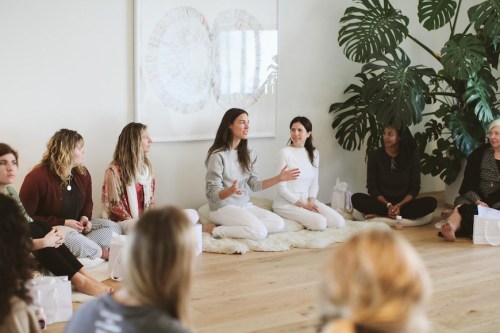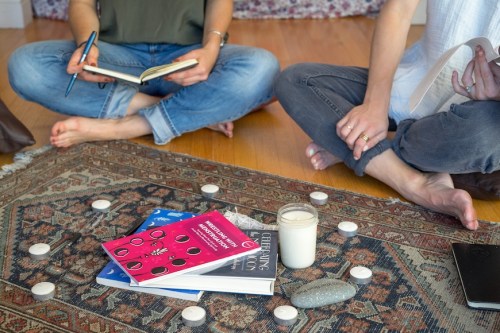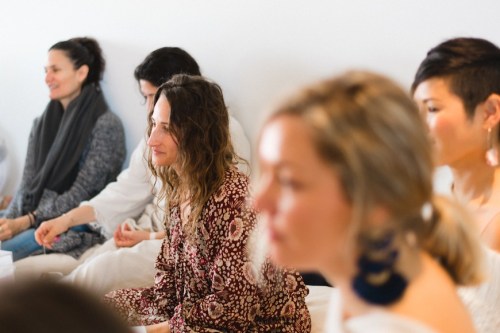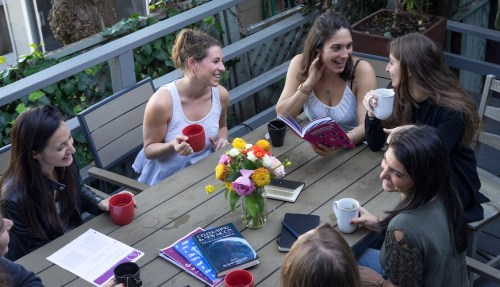The fascinating history behind your monthly women’s circle
New moon gatherings may be a major trend of the modern age, but they have a rich legacy. Here, experts tell the story of women's circles past, while sharing how their wellness benefits could impact our future.

Five years ago, if you’d told me that I’d be spending my Friday night at a new moon women’s circle, I would have rolled my eyes and asked you which strain of cannabis you were smoking. (And then promptly excused myself to meet my girlfriends at the bar.)
Yet this is exactly where I found myself last weekend—willingly, even. For two hours at Love Yoga in Venice, CA, a friend and I listened intently as facilitator Jana Roemer gave a download of the month’s astrological themes, then led our group of 30-plus women in an intention-setting session and a group share.
I’ve attended this circle several times in the past, and honestly, it’s way outside of my comfort zone. I tend to shy away from public displays of vulnerability in general, and as someone who faced her share of mean-girl experiences growing up, I’ve always felt extremely uneasy in large groups of women. But still, I know that this is an important step when it comes to improving my relationship with my own gender, and I always leave feeling a little lighter. And I’m clearly not the only one who’s realized that this kind of connection and community is incredibly healing, judging by the ever-growing size of this particular circle—not to mention the fact that women’s circles in general are going mainstream across the US.
As it turns out, we’re all just waking up to a practice that’s really ancient, albeit one that fell out of favor for centuries in the Western world. “This ritual of women gathering is so universal,” points out Sarah Waxman, founder of At The Well—a network that helps women create their own circles for Rosh Chodesh, a traditional Jewish new-moon meet-up. “It’s practiced in so many different cultures and faiths. Anyone who has a land-based heritage likely has a new moon women’s gathering [as part of it].”
With that in mind I decided to do a little digging, since knowing the history behind any experience makes it that much more powerful. And while I learned a lot about the women’s circles of the past, I also discovered some pretty compelling facts about the potential impact of these new-age sororities—intel that indicates they’re a lot more than just a fleeting wellness fad.
Keep reading for a primer on the past—and future—of women’s circles.

The tumultuous history of women’s circles
According to Ann Landaas Smith, founder and director of Circle Connections, humans have basically been gathering in the round since we began walking upright. “Circles with a sacred center are ancient, the oldest form of social interaction,” says the mentor and educator, who also works with Millionth Circle—an organization that helps women to start their own groups. “The fire was in the center as the people cooked and ate their food, heard stories, worshiped their gods and goddesses, and passed down the traditions and wisdom that kept them alive and healthy.”
Ladies-only circles, too, have been taking place for ages, all around the world. Many were directly tied to menstruation and the moon cycles, says Smith. “There are menstrual hut and moon lodge traditions all over the world that date back to 800 CE and in some places are still practiced today,” she says. While these largely have negative connotations now—women are basically being cast out of their communities for bleeding—Smith says there was an empowering side to them, once upon a time.
“The red tent [menstrual tradition] and moon lodges grew in popularity as a sacred space for women and girls to affirm their spirituality and sexuality, and to heal from the wounds of patriarchy [through connecting with each other],” she says.
Religion, too, played a role in the oldest women’s circles, like those practiced by the Wiccans and Celtic Christians in the 5th and 6th centuries. The obscure Jewish tradition of Rosh Chodesh is another example. “It means head of the month, the first sliver of the moon after it’s been dark,” says Waxman. “We know that it [involved] some combination of rest and learning, and in Judaism that’s the holiest thing you can do.”
So what happened between then and now to make women’s circles all but disappear from conventional culture? “We weren’t allowed to come together because it made people feel uncomfortable, and we were persecuted for it,” says Paula Mallis, circle facilitator and owner of WMN Space in Los Angeles.
“Those woman that have come before us have paved the way, creating space for this pivotal time where we are shifting, changing and transforming.”—Paula Mallis
This all happened even before the birth of America. “In 1484, the Hammer of Witches publication by two German Dominican monks began the systematic destruction of women’s spiritual practices and health care by torturing and murdering women healers and spiritual leaders,” says Smith. “This oppression lasted 500 years and was carried with colonialism to every corner of the Earth.” Waxman adds that even Rosh Chodesh circles faded from popularity—in part because of the Holocaust, which decimated the Jewish population and took many of its written historical records with it.
Of course, that didn’t completely stop women from getting together on their own terms, from sewing and quilting circles to tea dates and Mary Kay parties. “We were still called to gather, but we weren’t allowed to dip into an energy that would offend the power of the masculine,” says Mallis.
Spiritually driven (or, in some cases, psychedelic drug-fueled) women’s circles made a brief comeback in the ‘60s and ‘70s, but the movement was short-lived. “Something happened in the early ‘80s or ‘90s—I think the ritual just kind of stagnated,” says Waxman. “Maybe that’s because feminism across America stagnated, or that it was such a woo-woo thing that the mainstream wasn’t going to buy into it.”
Fast-forward 20 years, and Waxman believes that Sheryl Sandberg’s Lean In movement paved the way for our generation to discover women’s circles in the present day. They basically showed that by gathering together, setting goals, and talking about our challenges, women could make serious strides at work. And now that lunar everything is trending in a big way, we’re starting to bring the more esoteric aspect of old-timey women’s circles back into the equation, too.
“I believe the feminine rising is an opportunity for tremendous shifts in consciousness and on our planet,” says Mallis. “And though we still have work to do, those woman that have come before us have paved the way, creating space for this pivotal time where we are shifting, changing and transforming.”

How modern women’s circles make you happier…and healthier
As most women’s circle attendees will tell you, the experience is a lot different from, say, gossiping at a dinner party or talking shop at a networking event. “It’s a very different energy,” says Waxman. “We talk about community a lot when we’re not actually in community—[social] events don’t necessarily translate into a sense of belonging, and we still go home feeling alone. But when we’re in a setting where we’re not going to compete with each other, there’s a hormonal response that we’re safe. [And that allows us to] look each other in the eye and talk about real shit that’s going on in our lives.”
Part of this is because of the ritualized nature of a women’s circle. Even today’s facilitators often bring in ceremonial practices that help create a level playing field and encourage everyone to participate in the discussion. For Waxman’s Rosh Chodesh circle, that involves lighting a candle and asking everyone to state her mother’s and grandmothers’ names, per Jewish tradition. Mallis’ circles, which started out of her Venice Beach home several years ago, draw on indigenous culture. “In Native American women’s circles, there was a talking stick and storytelling—a lot of sharing and listening,” she says.
“When we’re in a setting where we’re not going to compete with each other, there’s a hormonal response that we’re safe.”—Sarah Waxman
Yet today’s facilitators have also found ways to make the ritual uniquely their own. “I take people through a process that includes identifying an issue that is not serving them, and I give them the tools they need to reframe it,” Mallis says. Adds Smith: “There are many kinds of circles depending on the needs of the members—they can be support circles, healing and wellness circles, spirituality circles, or action circles. Women’s circles are encouraged even within some churches.”
And the effects have been profound, which is what leads women to come back again and again. Mallis has seen relationships, new jobs, and creative breakthroughs come out of her circles, which have become so popular that she now hosts multiple sessions for each new and full moon. “My intention is that every woman who walks through the doors at WMN Space has an experience that supports her and empowers her to live her life at the fullest and most authentic level,” Mallis says. “WMN Circle is designed so that we may find deeper connections within ourselves and fully experience the magic that happens when like-minded women come together.”
Waxman has witnessed similar results in her own circle, and she now serves as a resource for over 100 other “Well Circles” for Jewish women via At The Well. “Finding a place to really ask questions and learn about my body from other like-minded friends has been a radical shift in my life,” she says.

The future of women’s circles
While most women’s circles today are relegated to yoga studios and living rooms, those in the know expect to see them reaching a wider radius of society in the years to come.
For one, we might see women’s circles at work become as prevalent as corporate yoga classes, as more workplaces wise up to the perks of a feminine leadership model based on cooperation and equality. Indeed, Mallis has already started fielding requests from LA-based businesses that want her to lead circles at their offices. “It’s based off of what they’re seeing online,” she says. “I’m like, whoa, this corporate company wants to experience a shift? It’s been really interesting.”
“We know [so] many women are suffering from depression, loneliness, and anxiety, and this is a ritual that is literally designed to combat that.”—Sarah Waxman
Waxman even envisions doctors prescribing women’s circles to their patients in the same way that they now do with meditation, specifically when it comes to treating mental health issues. “We know [so] many women are suffering from depression, loneliness, and anxiety, and this is a ritual that is literally designed to combat that,” she says, noting that the circle she attends has helped her in her own lifelong battle with depression. (Just look at all the recent research on telomeres for proof of the health-protective power of strong social connections.)
And ultimately, Waxman hopes that women’s circles will have an even bigger impact on healing the world at large. “If we can teach women around the world to be in these real types of communities designed for witnessing each other, [we may be able to convince] different groups of women in conflict to come together in these circles,” she says. “Can we get Israeli and Palestinian women to practice being in a women’s circle together? I don’t think the world knows what that would look like, but in a dreaming sense that’s really powerful.” Name a happy hour with that kind of impact—kinda makes you want to rethink your weekend plans, doesn’t it?
It’s not too early to start planning your summer solstice women’s circle—but why wait until then to get started? Here are some rituals you can do with your crew during the next new moon.
Sign Up for Our Daily Newsletter
Get all the latest in wellness, trends, food, fitness, beauty, and more delivered right to your inbox.
Got it, you've been added to our email list.










